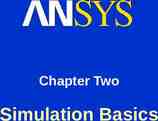Business process management (BPM) Petra Popovičová
16 Slides263.50 KB
Business process management (BPM) Petra Popovičová
BPM Management approach focused on aligning all aspects of an organization with the wants and needs of clients. It could be described as a "process optimization process„. Enables organizations to be more efficient, effective and capable of change than a functionally focused, traditional hierarchical management approach.
Business process (BP) Is "a collection of related, structured activities that produce a service or product that meet the needs of a client„, Is often used as synonymous of management of middleware processes; or integrating application software tasks, Foundation is very similar to other Total Quality Management or Continuous Improvement Process methodologies or approaches.
BPM life-cycle Business process management activities can be grouped into five categories: Design Modeling Execution Monitoring Optimization
Design Process Design encompasses both the identification of existing processes and the design of "to-be" processes. The aim is to ensure that a correct and efficient theoretical design is prepared. The proposed improvement could be in humanto-human, human-to-system, and system-tosystem workflows, and might target regulatory, market, or competitive challenges faced by the businesses.
Modeling Modeling takes the theoretical design and introduces combinations of variables (e.g., changes in rent or materials costs, which determine how the process might operate under different circumstances). It also involves running "what-if analysis" on the processes: "What if I have 75% of resources to do the same task?" "What if I want to do the same job for 80% of the current cost?".
Execution Process Automation is: to develop/purchase an application that executes the required steps of the process, to use a combination of software and human intervention - more complex difficult documentation proces. Developed software enables the full BP to be defined in a computer language directly executed by the computer. The system will use services in connected applications to perform business operations, or, when a step is too complex to automate, will ask for human input. A business rule engine can be used to drive process execution and resolution
Monitoring Tracking of individual processes, so, that information on their state can be easily seen, and statistics on the performance of one or more processes can be provided. The degree of monitoring depends on what information the business wants to evaluate and analyze and how business wants it to be monitored, in real-time, near real-time or ad-hoc. Process mining is a collection of methods and tools related to process monitoring. The aim of this is to analyze event logs extracted through process monitoring and to compare them with an a priori process model. It allows to detect discrepancies between the actual process execution and the a priori model.
Optimization Process optimization includes retrieving process performance information from modeling or monitoring phase; identifying the potential or actual bottlenecks and the potential opportunities for cost savings or other improvements; and then, applying those enhancements in the design of the process.
Example of BPM Service Pattern: (implement BP throught the orchestration of activities between people and systems)
BPM technology Is define as: „The whole of BMP“, or Information moving between enterprise software packages and immediateli think of Service Oriented Architecture(SOA). Today encompasses the concept of supporting the managerial approach trhough enabling technology. BMPS should facilitate business process change throughout the life cycle – this will assist in the automation of activities, collaboration, integration with others systems.
Critical components of a BMP Suite Process engine – platform for modeling and executing process-based apllications (including business rules) Business Analytics – identification business issues and reaction accordingly Content Management – system for storing and securing electronic documents Collaboration Tools – remove communication bariers, dynamic workspace
The Business Process Modeling Notation (BPMN) Graphical representations of BP. Is supported with appropriate graphical object properties that will enable the generation of executable BPEL (Business Process Execution Language). Creates a standardized bridge for the gap between the business process design and process implementation.
Example of using BPMN to model a BPEL process (Setting up the BPEL Information)
Literature 1. http://en.wikipedia.org/wiki/ Business Process Management 2. http://en.wikipedia.org/wiki/ Business Process 3. http://en.wikipedia.org/wiki/BPEL 4. http://en.wikipedia.org/wiki/Business Pro cess Modeling Notation 5. http://www.omg.org/bpmn/Documents/ Mapping BPMN to BPEL Example.pdf
Thanks for your attention





















